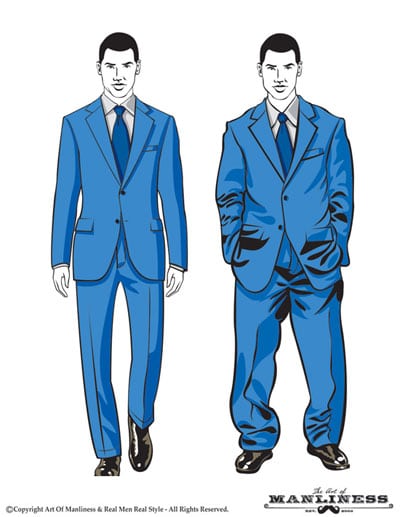Shared posts
7 Quick Takes
10 Food Preservation Tips in 60 Seconds
Keep Your House in Tip-Top Shape: An Incredibly Handy Home Maintenance Checklist

When buying a home, most people probably first think of the financial responsibility. Don’t let yourself forget, however, about the time and labor that home ownership also requires. Just like regular oil changes for your car keep your engine happy and healthy, keeping up with regular home maintenance tasks will keep you from future headaches and wasted money.
It can be intimidating to think about these various tasks, especially if you’re a new homeowner. It’s a long list — there’s no denying that. The good news is that you can do the majority of it on your own without much experience. Google is your best friend, and if you really get stuck, call up your local handyman to help you out.
In order to maximize your efficiency and actually get all of these tasks done, you might want to create a home maintenance calendar for yourself. Whether online or on paper, you can jot down small, regular tasks for each weekend and not be too overwhelmed. We’ve listed tasks that need to be done monthly, quarterly, and biannually. We’ve also given you a list of tasks to be completed seasonally. Not every expert agrees as to which task needs to be done in which season, so this isn’t a black and white list, necessarily. Do what works for you and your schedule, and as long as all these things get accomplished, your home will be happy for years and years to come.
Monthly
- Inspect, and possibly change out HVAC filters. Many experts will say to change the filters monthly, but that’s not always necessary. For smaller families without pets or allergies, you’ll likely be okay changing the filters every 2-3 months. If the filter is dirty, change it out, otherwise inspect it again next month. I’ve also been told by handymen to go with cheaper filters and replace them more often versus going with the expensive filters.
- Clean kitchen sink disposal. There are a bunch of ways to do this, but the handiest and best all-around solution seems to be vinegar ice cubes. Put some vinegar in an ice tray and let it freeze, then run the ice cubes through the disposal. It freshens it, but as a bonus, ice sharpens the blades. You’re welcome.
- Clean range hood filters. If you’ve never thought of doing this, you’re in for a real “treat” when you get that filter off the hood to clean it for the first time. The Family Handyman suggests simply using a degreaser from an auto parts store mixed with hot water. Let the filter sit for a few minutes, rinse it off, and you’re good to go.
- Inspect your fire extinguisher(s). We’ll assume you have and know how to use an extinguisher. This inspection doesn’t require much: ensure it has easy access (not being blocked by a garbage can or anything else), that the gauge shows adequate pressure, and that it has no visible signs of wear and tear.
Quarterly
- Test smoke/carbon dioxide detectors. Another simple task; your detectors should have a “test” button. If the alarm sounds, you’re good to go. If not, replace batteries immediately and test again. If it still doesn’t sound, it’s possible there’s simply corrosion on the battery terminal, and it won’t detect new batteries. Clean it and try again. If it still doesn’t work, you’ll likely need a new detector.
- Test garage door auto-reverse feature. In 1993, federal law required all garage doors to have this feature after multiple child deaths. Test every month by placing a 2×4 on the ground where the door would close. It should reverse after a second or so when the door hits the wood. Also test the photo-electric sensors if you have them by placing something in front of them (not your body). If the door doesn’t immediately go back up, you have a problem.
- Run water and flush toilets in unused spaces. This mostly applies to guest bathrooms, or any other sinks/water sources you don’t use on a regular basis. The idea is to prevent grime or any other kind of build up. Regularly running a little bit of water through will prevent this.
- Check water softener, add salt if needed. You shouldn’t need to add salt every month, but better to check anyway, as it only takes about 5 seconds.
Biannually
- Test your water heater’s pressure relief valve. This will prevent mineral and corrosion buildup, which safeguards against leaks. It will also help your heater run more efficiently.
- Give your house a deep clean. Take one Saturday every six months with your whole family, and give the whole house a proper deep clean. Appliances, windows, dusting every nook and cranny (including the basement), etc. Keeping things clean and not letting dirt/grime/dust build up over years and years will help keep your home in tip-top shape.
- Replace batteries in smoke/carbon dioxide detectors. I’d never heard this before, actually. I just assumed you changed it out when it started giving you the low battery beeping noise. This tip was in everything we researched, however. With something as important as this, you can’t be too careful, and batteries won’t break your bank. Change ‘em out every six months.
- Vacuum your refrigerator coils. I actually learned this tip from a refrigerator repairman, and our research confirmed it. The fridge can use up to 15 percent of your home’s total power, so you want it running as efficiently as possible. Over time, the coils get dirty and your fridge requires more juice. You can save up to $100 a year by doing this, and it’s not at all a difficult task.
Annually (Organized by Season)
Spring
Spring is a big month for home maintenance. They don’t call it “Spring Cleaning” for nothing. Especially focus on the exterior of your home as it’s just gone through winter and is preparing for summer heat, and in some parts of the country, brutal humidity.
- Check the exterior drainage. Will rain water flow away from the house? Puddles should not stand around your home for more than 24 hours. If water stays, or moves toward your foundation, you have a few options. First, check your gutters. It could be a bad spout or a loose connection there; they may also just need cleaning. Second, you can grade the area around your home yourself with some dirt; this has worked just fine for me in the past. Third, for pavement, you can have professionals come out and raise it so it drains away from your home.
- Clean out gutters. They’ve likely accumulated leaves from the fall and grime/sediment from the winter snows and/or rains.
- Inspect the exterior of your home. Is any paint chipping? Is any siding damaged from winter? Are there any holes in your brick? Take a close look all around your house, and make any repairs as needed. Also be sure to check the foundation for any cracks. A good silicone/caulk can fix a lot of your problems.
- Get your air conditioning system ready for summer; consider having it serviced. This one really depends on your individual home, and even which part of the country you live in. Some places mostly just use window air units, while other places (like my home in Colorado) use a big swamp cooler up on the roof — these are fairly basic machines where a quick internet search can help you fix any issues that come up. Also refer to the user guides for specific regular maintenance. Central air is obviously a more complex system. Getting it serviced by a professional should be around $100 or less, and it will save money and headaches down the road.
- Repair/replace damaged window screens. You don’t want bugs making their way in because you missed a hole in a window screen. And no, duct tape doesn’t count. It can be a quick fix, but don’t leave it for long. It just looks bad.
- Clear dead plants/shrubs from the house. This could double as a gardening tip, but if you didn’t trim trees or shrubs in the fall, do so now. Plants can weasel their way into cracks and holes on the exterior of your home, causing damage and shortened longevity. Nip that in the bud before it’s an issue. If you have decorative vines on the exterior, pay close attention.
- Check trees for interference with electric lines. Have professionally trimmed if necessary.
- Inspect roofing for damage, leaks, etc. Repair as needed; you may need a professional.
Summer
Summer is a great time to focus on the exterior of your home, as well as your lawn and garden. It’s also perfect for having that garage door open and utilizing the prolonged daylight to work on any manly projects you’ve had on the backburner.
- Check grout in bathrooms, kitchen, etc.; repair as needed. This will prolong the life of your tiled surfaces and just looks better.
- Inspect plumbing for leaks, clean aerators on faucets. Go around to all your faucets and toilets and check for any small leaks. If you have poor water pressure out of a faucet, the aerator is the likely culprit and it’s an extremely easy fix.
- Take care of any insect problems you may have. Summer is their playground. You probably won’t have to look too hard to notice any insect problems. Ants, spiders, moths, etc. are all common, and fairly easy to take care of. Keep cobwebs clear, have ant poison handy, make sure all doors are tightly closed, etc. If termites are common in your area, this handy article gives some tips on how you can do some inspection and prevention yourself.
- Clean and repair deck/patio as needed. It generally just needs a good washing. A deck may also need re-staining. Also check for any loose boards or posts and repair as needed.
- Clean out window wells of debris. If you have a basement, you also have window wells. All kinds of things can get down in there from leaves, to trash, to animals.
- Check and clean dryer vent, other exhaust vents to exterior of home. While the dryer is running, check that the exhaust is coming out. It should smell nicely of fresh laundry. If there isn’t much exhaust, check for blockages as well as you can. You may need a professional. Also vacuum the lint from the hose at the dryer.
- Clean garage. Cleaning the garage should be a summer ritual for every man. Keeping it clean and tidy will extend its life, and it often gets neglected of regular care. With all the extra dust it gets from the manly projects you’re working on, you should actually clean it even more. Once a year, however, give a thorough going-through.
Fall
Fall is an in-between season where you’re finishing up your summer home maintenance tasks as well as getting your home ready for winter. Cold, snow, and rain can do a number to a home, so you don’t want to ignore winter preparation.
- Flush hot water heater and remove sediment. This prolongs the life of the heater and helps with efficiency as well.
- Winterize air conditioning systems. Remove and store window units. If you have central air, cover the outside unit with a tarp or plastic sheeting and secure with bungee cords.
- Get heating system ready for winter. Check for any leaks in windows or doors; these can cost an arm and a leg. Make sure heating vents are open and not blocked by furniture. Get furnace serviced/inspected at least every other year, preferably annually. As with the AC, this shouldn’t be a huge expense. Don’t forget about fireplaces if you have them.
- Turn off and flush outdoor water faucets. Also flush hoses and store them. Winterize sprinkler systems as well, if you have one.
- Get chimney cleaned, if you have one. Some folks say to do this in the spring, some say fall. Either way, just make sure it’s done once per year.
- Test sump pump. You don’t want to wait until you need your sump pump to find out it’s not working.
- Check driveway/pavement for cracks. Make sure to have re-sealed before winter; water can freeze and expand in the cracks, causing more damage.
- Buy winter gear. Have sidewalk salt, good shovels, etc. ready for winter. You never know when that first snow will come!
Winter
Winter is the time to go around the interior of your home and check for any little things you may have overlooked, or perhaps noticed and said, “I’ll get to that later.” Winter is your later. If you have any interior honey-do projects, whether it be painting, building shelves, etc., now is a great time to tackle those as well.
- Regularly check for ice dams and icicles. De-icing cables that sit at the front of the roof work well. Don’t let icicles grow, as much as the kids may want you to. They’re not only a danger to people standing beneath them, but they’re incredibly heavy and can cause damage to your home. They also can cause water damage to your foundation when they melt.
- Test your electricity to the extent that you can. Always, always be extra careful when working with electricity. You can do a couple things on your own, though. Check that all outlets work; if they don’t, you can re-wire them on your own. Also, test your GFCI outlets. There are wildly varying opinions on how often to test this. Some say monthly, others say annually.
- Tighten any handles, knobs, racks, etc. Go through the house and inspect anything that could have a loose screw.
- Check all locks and deadbolts on your doors and windows. If anything doesn’t work right, replace.
- Check caulking around showers and bathtubs; repair as needed.
- Remove showerheads and clean sediment. This prolongs its life and helps with water pressure as well.
- Deep clean and inspect the basement. Basements are notoriously overlooked, especially if they’re primarily just storage areas. Dust ‘em up, clean any windows, make sure there isn’t mold anywhere, etc. Give your basement a good inspection at least once a year.
While this list is certainly extensive, it’s not a complete list of all the things you can do for your home. What do you do to keep your home in tip-top shape? Do you have any hacks for doing these tasks as efficiently and effectively as possible?
Related posts:
- 15 Ways to Winterize Your Home
- 9 Ways to Winterize Your Car
- How to Buy a Used Car
- Troubleshooting Your Windshield Wipers: How to Fix 5 Common Problems
- The Uncle Buzz Workout: How to Get in Shape Without the Gym
How Should a Suit Fit? Your Easy-to-Follow Visual Guide
If you’re dressing on a budget, one of the most popular pieces of advice out there is to buy off-the-rack suits in the best fit you can get, and then take them to a tailor for custom adjustments.
That’s good advice. You’ll find it in several articles right here on the Art of Manliness.
But if you’re really going to get any benefit out of having your suits adjusted, you need to know a little bit about tailors and the kinds of adjustments they can (and can’t) make.
You also need to know what a “good” fit actually looks like.
Tailors vary in skill and in how they communicate the work they’re doing, so getting a suit adjusted is only going to deliver a good return if you can make your exact needs clear.
Below, we give you an easy-to-follow rundown on how your suit should fit.
What a “Good Fit” Looks Like
When you try on a suit, you’re looking for a good fit in what’s called your “natural stance.”
That means standing up straight, preferably in the kind of dress shoes you’ll be wearing with your suits, with your arms relaxed at your side.
It’s not actually a very natural posture for a lot of us, but it is the base from which most of our movement flows. If the suit doesn’t fit well in this stance, it’s not going to move comfortably with your body either.
Practice standing in that relaxed, upright pose, and then start trying on suits in that posture. Look for a good fit in the following areas when you’re in your natural stance:
The Shoulder
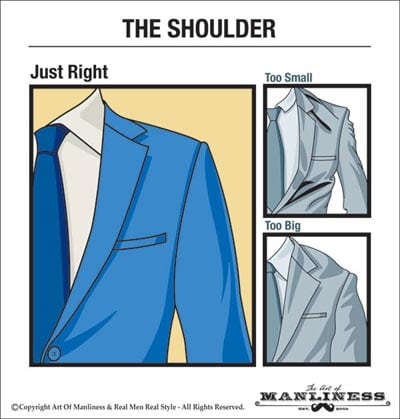
A well-fitted shoulder lies flat. The seam on top of the shoulder should be the same length as the bone under it, and should meet the sleeve of the suit right where your arm meets your shoulder.
If the seam that connects the sleeve to the jacket is hiked up along your shoulder bone, or dangling down on your upper bicep, the jacket is never going to sit properly. In these instances, you’ll see “ripple effects” that create lumps or wrinkles on the sleeve and the top of the jacket.
Shoulders are one of the hardest parts of a jacket to adjust after construction, so don’t buy a piece with an ill-fitted shoulder. Odds are you’ll never be able to get it quite right with post-purchase alterations.
The Seat
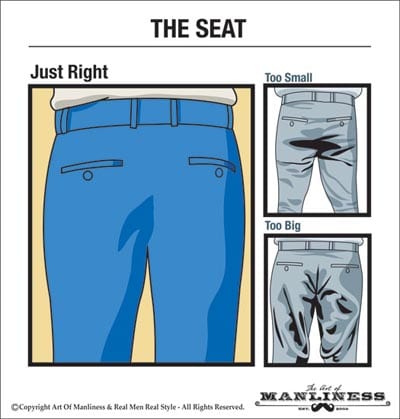
The back of your trousers should be a smooth drape over the shape of your rear end — whatever that happens to be.
A good fit in the seat will lie loosely against your underwear, without pulling tight against your butt or draping loosely down your thighs.
You can spot a bad fit in the seat when there are horizontal wrinkles just under the buttocks (caused by too tight of a fit), or by loose, U-shaped sags on the backs of the thighs (caused by too loose of a fit).
A tailor can “take in” a seat to make it tighter in the back without too much difficulty, but there’s a limit to how far he can go. If the seat was way too loose to begin with, it’s not possible to adjust it to fit without pulling the pockets out of place.
Unless the pants have an unusual amount of spare cloth on the inside, seats can’t be “let out” very far to make the fit looser. Err on the side of too loose rather than too tight when buying.
Trouser Break
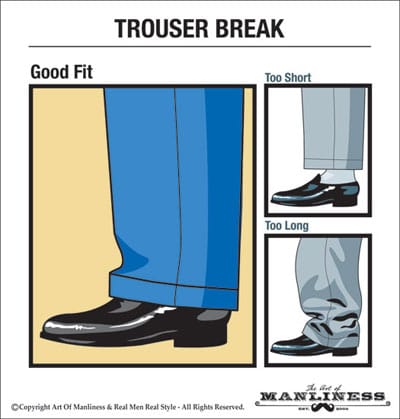
The “break” is the small wrinkle caused when the top of your shoe stops your trouser cuff from falling to its full length.
This should be a small, subtle feature. One horizontal dimple or crease is usually ideal. The cuff should indeed rest on the top of your shoe — there needs to be contact — but it shouldn’t do much more than that. The trouser can fall a touch longer in the back than in front, so long as it’s still above the heel of the shoe (the actual heel, not just the back of the shoe).
This is one of the easiest adjustments to make, so you can rely on making some changes here if you need to. In fact, dress pants are often sold unhemmed, with the assumption that the purchaser will take the trousers to a tailor (or make use of the store’s tailor if there is one) to have the cuffs fitted.
The Jacket Closure
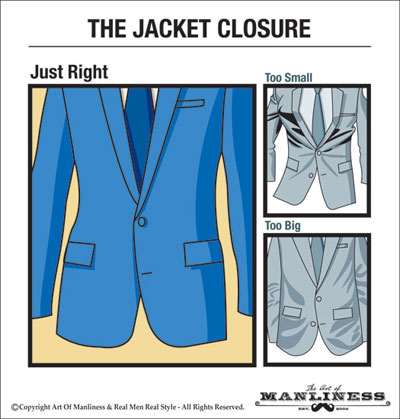
When you are wearing a suit and standing, you should have the jacket buttoned (you know the jacket buttoning rules, right? Click here to learn!).
This means that part of the trying-on process is checking how the front of the jacket closes over your body.
Close a single-breasted jacket with only one button when you’re testing the fit, even if it’s a three-button jacket. You’re looking to see if the two sides meet neatly without the lapels hanging forward off your body (too loose) or the lower edges of the jacket flaring out like a skirt (too tight).
The button should close without strain, and there should be no wrinkles radiating out from the closure. A little bit of an opening at the bottom of the suit is fine, but the two halves beneath the button shouldn’t pull apart so far that you can see a large triangle of shirt above your trousers. (Ideally, you shouldn’t see any, though a bit is socially acceptable, especially when you move.)
Taking in or letting out the waist to help the jacket close more comfortably is not a difficult adjustment, but it’s one with limits. Don’t expect a tailor to be able to make huge changes here. If the jacket closure looks really bad unaltered, it’s probably due to problems beyond the waist measurement, and you should be looking for a different jacket rather than planning on getting that one altered.
Jacket Sleeve Length
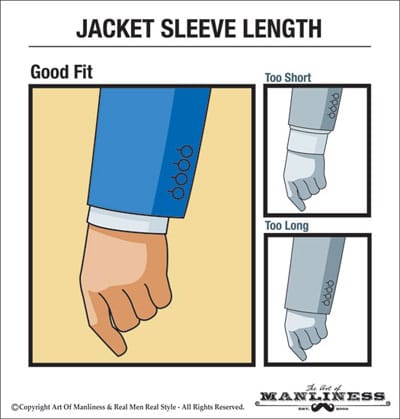
“A half-inch of linen” is a good, old-fashioned guideline for the relationship between a suit jacket and the shirt worn under it — about half an inch of the shirt cuff should be visible beyond the jacket cuff.
That said, it’s a general guideline, and you don’t need to get too obsessive. What you do need to be sure of is that the suit sleeve doesn’t rise above the cuff entirely — the seam where the shirt cuff joins the shirt sleeve should never be visible.
Similarly, the jacket sleeve should never hide the shirt sleeve entirely. At least a small band of shirt cuff should always be visible.
For most men, that ends up being a jacket sleeve that terminates just above the large bone in the wrist. But everyone’s arms are slightly different, and sleeve length is a very easy adjustment for a tailor to make, so get the best sleeve length you can (erring on the side of too long if possible) and then have it adjusted to fit.
Jacket Length

Not enough time or writing gets devoted to the overall length of men’s jackets. It’s more important than most people think!
A good suit or sports jacket should fall past the waist and drape over the top of the curve formed by the buttocks. An ideal fit will cover a man down to the point where his butt starts to curve back inward, and stop there (but anywhere in that general region is okay).
The hands are also a good marker here, and this is why it’s important to have your arms relaxed in your natural stance. The hem of the jacket should hit right around the middle of your hand — at or just past where the fingers meet the palm.
If the hem of the jacket is sitting on top of the butt, with a small little flare in the back, it’s too short. If it falls past the bottom entirely, longer than the arms, it’s too long. The hem can be adjusted upward without too much trouble, but if you go too far the front pockets start to look out of proportion, so don’t count on more than an inch or two of adjustment here.
Jacket Collar

It’s easy to tell a well-fitted collar from a poorly-fitted one, although identifying the cause of the bad fit can be challenging.
Your jacket collar should rest against your shirt collar, which in turn should rest against the back of your neck. All of these should touch lightly, without significant gaps in between.
If the collar is too loose, it’s very easy to spot — there will be a gap where it’s flopping back off your neck.
A tight collar is a little harder to spot on a jacket, since (unlike a shirt collar) it’s almost all in the back. Turn from side to side as needed and check it out in a mirror. A tight collar will create bunching and folds just beneath it, and often wrinkles the shirt collar underneath it as well.
Bad collar fit could just mean the neck size is wrong for you, but it’s often caused by a larger fit issue: bad shoulder sizing, a back panel that’s too small for you, or even a jacket that’s constructed with more of a forward or backward tilt than your neutral stance.
Since these adjustments cost time and money to fix, you want to get as good of a fit in the original jacket as possible at the collar.
Four Automatic “Bad Fit” Warnings
There are a couple of easy to spot problems that are major warning signs. A suit with these “bad fit” signs is one that you probably won’t ever be able to adjust to a really good fit.
Unfortunately, most of them are caused by the core structure of the suit — and that means that your body just isn’t a good match for the way that particular brand makes its pieces.
Be patient, try on lots of brands, and don’t compromise (unless you know it can be fixed!).
If you can’t afford bespoke (made to order), an adjusted off-the-rack suit can work — but you have to start with a pretty good fit in the first place, or it’s never going to get the results you want.
Unless you want to pay for alterations, be careful buying any jacket that’s showing these serious warning signs:
The Dreaded X-Shaped Button Strain
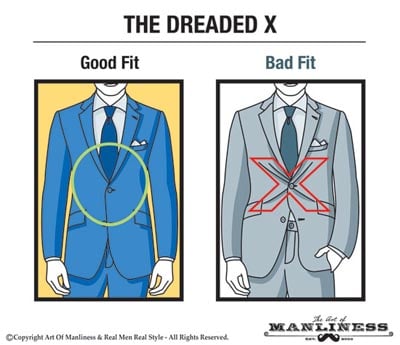
If you can see wrinkled lines radiating outward from your jacket button when you close the jacket, it’s too tight and will need adjustment.
The Dreaded X, as my friend Barron over at Effortless Gent likes to call it — is not a look you seek in a well-fitted jacket.
Front button strain is indicative of a bad fit in the torso, and it can go beyond just the waist size — you’re probably straining at the shoulders or in the back, too. On a more basic note, it also means the button is going to be prone to popping off.
Don’t buy a jacket that shows strain lines radiating outward from the button. If you’ve got an old jacket that used to fit but has started showing them, it’s possible that you’ve either gained weight or accidentally shrunk the jacket in a wash — in that case (assuming the fit was good before), you may be able to have the waist let out a little and keep the jacket in use.
Shoulder Divots & Upper Arm Wrinkles
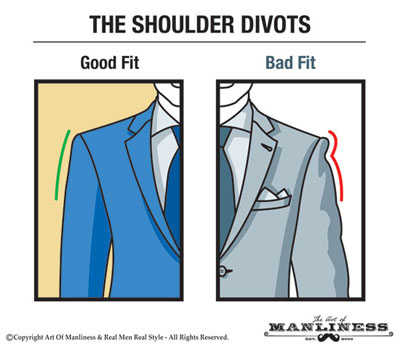
If the sleeve of the jacket seems to dip in slightly just under the shoulder, and then flare back out again, the shoulders are too big. What you’re seeing is the shoulder padding protruding beyond your arm, and the cloth of the sleeve tucking back in underneath it.
You can also get those wrinkles if you’ve got a somewhat slouched stance and the jacket is stiffly-constructed for a more upright posture. In either case you’ll need to get a smaller size, so that the seam where the shoulder meets the sleeve matches up with your body’s shoulder, or give up and try a different brand.
Shoulder Wrinkles — Top Rumpling
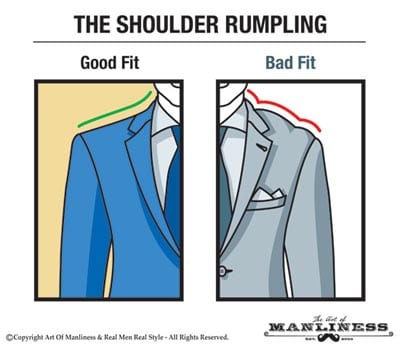
If you’re getting noticeable bunching on top of your shoulder, rather than on the upper sleeve, the jacket is too large in the shoulders.
This could be a simple length problem, but more likely it’s that the interior space is simply too large — your shoulders aren’t broad enough, front to back, to fill out the jacket.
Try a slimmer fit, if the manufacturer offers multiple styles, or a smaller size. If you’re still seeing wrinkles on the tops of your shoulders, the brand probably isn’t going to work for you.
Twisted Sleeves — Bad Sleeve Pitch
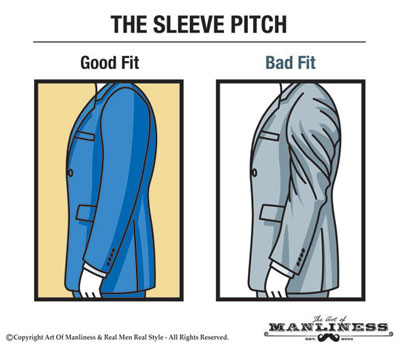
Faint spiraling wrinkles on the outside of the sleeve occur when the angle of your arm in its natural stance doesn’t match the angle that the sleeve was constructed with. The result is a sleeve that looks slightly twisted even when your arms are hanging still at your sides.
A tailor can theoretically remove the sleeves and reattach them at a slightly different angle, but it’s not a simple or a cheap fix. Generally speaking, you can consider this one a deal-breaker. Keep trying until you find a jacket where the sleeves fall smooth and straight when your arms are resting in their natural stance.
Watch a Video Summary of This Post
_______________________________________
Written By:
Antonio Centeno
Founder of Real Men Real Style
Creator of The Style System – a college-level course that teaches the foundations of professional dressing so you control the message your image sends.
Related posts:
- The Art of Manliness Suit School: Part II – The Alterations Every Man Needs
- The Sometimes, Always, Never 3-Button Rule
- A Man and the Sports Jacket: A Tailored Suit’s Sports Jacket Giveaway
- Interviewing in a Recession: How to Dress for a Job Interview in Hard Times
- Measuring the Man: How to Measure Yourself for Clothing (Plus a Bonus Personal Sizing Card)
How About Here? Is This Good?
Secret Fore-Edge Paintings Revealed in Early 19th Century Books at the University of Iowa

Autumn by Robert Mudie / Special Collections & University Archives at the University of Iowa

Autumn by Robert Mudie / Special Collections & University Archives at the University of Iowa

Winter by Robert Mudie / Special Collections & University Archives at the University of Iowa

Winter by Robert Mudie / Special Collections & University Archives at the University of Iowa

Spring by Robert Mudie / Special Collections & University Archives at the University of Iowa

Spring by Robert Mudie / Special Collections & University Archives at the University of Iowa

Summer by Robert Mudie / Special Collections & University Archives at the University of Iowa

Summer by Robert Mudie / Special Collections & University Archives at the University of Iowa
A few days ago Colleen Theisen who helps with outreach and instruction at the Special Collections & University Archives at the University of Iowa shared an amazing gif she made that demonstrates something called fore-edge painting on the edge of a 1837 book called Autumn by Robert Mudie. Fore-edge painting, which is believed to date back as early as the 1650s, is a way of hiding a painting on the edge of a book so that it can only be seen when the pages are fanned out. There are even books that have double fore-edge paintings, where a different image can be seen by flipping the book over and fanning the pages in the opposite direction.
When I realized the book Theisen shared was only one of a series about the seasons, I got in touch and she agreed to photograph the other three so we could share them with you here. Above are photos of Spring, Summer, Autumn and Winter which were donated to the University of Iowa by Charlotte Smith. How much fun are these? Keep an eye on the University of Iowa’s special collections Tumblr as they unearth more artificats from the archives.
Update: Because this post is getting so much attention, here are some more amazing fore-edge paintings found on YouTube.
"Welcome Among the Least" – On Europe's "Island of Tears," Pope Asks Church: "Where Is Your Brother?"
Immigrants who died at sea, from that boat that, instead of being a way of hope was a way of death. This is the headline in the papers! When, a few weeks ago, I heard the news – which unfortunately has been repeated so many time – the thought always returns as a thorn in the heart that brings suffering. And then I felt that I ought to come here today to pray, to make a gesture of closeness, but also to reawaken our consciences so that what happened would not be repeated. Not repeated, please! But first I want to say a word of sincere gratitude and encouragement to you, the residents of Lampedusa and Linosa, to the associations, to the volunteers and to the security forces that have shown and continue to show attention to persons on their voyage toward something better. You are a small group, but you offer an example of solidarity! Thank you! Thanks also to Archbishop Francesco Montenegro for his help and his work, and for his pastoral closeness. I warmly greet the Mayor, Mrs Giusy Nicolini. Thank you so much for all you have done, and for all you do. I give a thought, too, to the dear Muslim immigrants that are beginning the fast of Ramadan, with best wishes for abundant spiritual fruits. The Church is near to you in the search for a more dignified life for yourselves and for your families. I say to you “O’ scia’!” [trans.: a friendly greeting in the local dialect].
This morning, in light of the Word of God that we have heard, I want to say a few words that, above all, provoke the conscience of all, pushing us to reflect and to change certain attitudes in concrete ways.
“Adam, where are you?” This is the first question that God addresses to man after sin. “Where are you Adam?” Adam is disoriented and has lost his place in creation because he thought to become powerful, to dominate everything, to be God. And harmony was broken, the man erred – and this is repeated even in relations with his neighbour, who is no longer a brother to be loved, but simply someone who disturbs my life, my well-being. And God puts the second question: “Cain, where is your brother?” The dream of being powerful, of being as great as God, even of being God, leads to a chain of errors that is a chain of death, leads to shedding the blood of the brother!
These two questions resonate even today, with all their force! So many of us, even including myself, are disoriented, we are no longer attentive to the world in which we live, we don’t care, we don’t protect that which God has created for all, and we are unable to care for one another. And when this disorientation assumes worldwide dimensions, we arrive at tragedies like the one we have seen.
“Where is your brother?” the voice of his blood cries even to me, God says. This is not a question addressed to others: it is a question addressed to me, to you, to each one of us. These our brothers and sisters seek to leave difficult situations in order to find a little serenity and peace, they seek a better place for themselves and for their families – but they found death. How many times to those who seek this not find understanding, do not find welcome, do not find solidarity! And their voices rise up even to God! And once more to you, the residents of Lampedusa, thank you for your solidarity! I recently heard one of these brothers. Before arriving here, he had passed through the hands of traffickers, those who exploit the poverty of others; these people for whom the poverty of others is a source of income. What they have suffered! And some have been unable to arrive!
“Where is your brother?” Who is responsible for this blood? In Spanish literature there is a play by Lope de Vega that tells how the inhabitants of the city of Fuente Ovejuna killed the Governor because he was a tyrant, and did it in such a way that no one knew who had carried out the execution. And when the judge of the king asked “Who killed the Governor?” they all responded, “Fuente Ovejuna, sir.” All and no one! Even today this question comes with force: Who is responsible for the blood of these brothers and sisters? No one! We all respond this way: not me, it has nothing to do with me, there are others, certainly not me. But God asks each one of us: “Where is the blood of your brother that cries out to me?” Today no one in the world feels responsible for this; we have lost the sense of fraternal responsibility; we have fallen into the hypocritical attitude of the priest and of the servant of the altar that Jesus speaks about in the parable of the Good Samaritan: We look upon the brother half dead by the roadside, perhaps we think “poor guy,” and we continue on our way, it’s none of our business; and we feel fine with this. We feel at peace with this, we feel fine! The culture of well-being, that makes us think of ourselves, that makes us insensitive to the cries of others, that makes us live in soap bubbles, that are beautiful but are nothing, are illusions of futility, of the transient, that brings indifference to others, that brings even the globalization of indifference. In this world of globalization we have fallen into a globalization of indifference. We are accustomed to the suffering of others, it doesn’t concern us, it’s none of our business.
The figure of the Unnamed of Manzoni returns. The globalization of indifference makes us all “unnamed,” leaders without names and without faces.
“Adam, where are you?” “Where is your brother?” These are the two questions that God puts at the beginning of the story of humanity, and that He also addresses to the men and women of our time, even to us. But I want to set before us a third question: “Who among us has wept for these things, and things like this?” Who has wept for the deaths of these brothers and sisters? Who has wept for the people who were on the boat? For the young mothers carrying their babies? For these men who wanted something to support their families? We are a society that has forgotten the experience of weeping, of “suffering with”: the globalization of indifference has taken from us the ability to weep! In the Gospel we have heard the cry, the plea, the great lament: “Rachel weeping for her children . . . because they are no more.” Herod sowed death in order to defend his own well-being, his own soap bubble. And this continues to repeat itself. Let us ask the Lord to wipe out [whatever attitude] of Herod remains in our hears; let us ask the Lord for the grace to weep over our indifference, to weep over the cruelty in the world, in ourselves, and even in those who anonymously make socio-economic decisions that open the way to tragedies like this. “Who has wept?” Who in today’s world has wept?
O Lord, in this Liturgy, a Liturgy of repentance, we ask forgiveness for the indifference towards so many brothers and sisters, we ask forgiveness for those who are pleased with themselves, who are closed in on their own well-being in a way that leads to the anaesthesia of the heart, we ask you, Father, for forgiveness for those who with their decisions at the global level have created situations that lead to these tragedies. Forgive us, Lord!
O Lord, even today let us hear your questions: “Adam, where are you?” “Where is the blood of your brother?” Amen.
Per Vatican Radio, the exchange – amplified by microphones – went as follows:
Pope: I thank you for this welcome, all of us together today will pray for each other and also for those who are not here with us today. Thank you.
Migrant: First of all, we thank the Holy Father for his visit. We would like him to resolve our problem. We fled our country for two reasons: political and economic. To arrive here, in this tranquil place, we overcame many obstacles; we were kidnapped by many traffickers. To arrive here, also again in Libya, we have suffered greatly. We would like the Holy Father’s help and we, after a long period of suffering, we have arrived here; we would like other countries to help us. Thank you for your collaboration and we thank God. We here are forced to remain in Italy because Italy has many refugees. We have stayed, we have digital fingerprints and for this we are forced to stay; we are very many migrants and we would like other European countries to help us.
As noted by Catholic News Service, the ritual text employed by Francis was that of a Mass of Reparation ("for the Remission of Sins") in light of the suffering of the innocent, the Pope and his concelebrants – some of whom wore ballcaps to shade themselves from the summer sun – all vested in penitential violet.
On leaving the migrant group to head to Mass by means of an open jeep, a lucky TV crew was able to stick a microphone in front of Francis and get his unscripted mind on the moment.
"I'm here to pray," the Pope said. "And I want to help."
-30-





